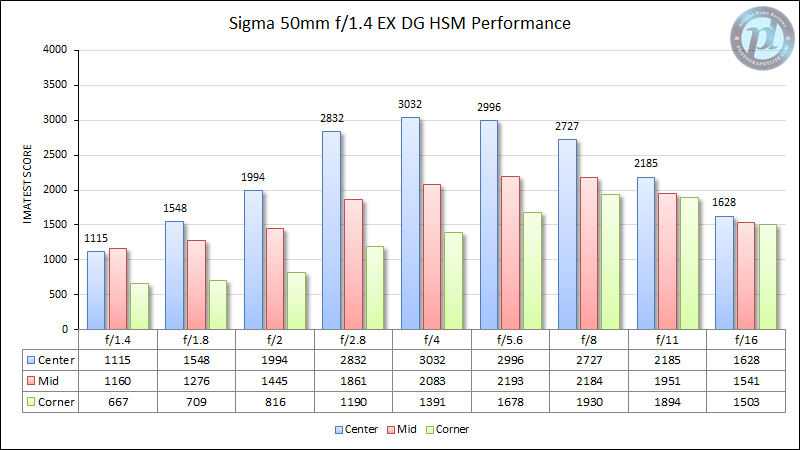Sigma 50mm f/1.4 EX DG HSM vs Nikon 50mm f/1.4G
The Nikon 50mm f/1.4G is Nikon’s fastest 50mm AF lens and it is a direct competitor to the Sigma 50mm f/1.4. Before I go over the test results, I would like to point out that the Sigma 50mm has a wider field of view compared to Nikon 50mm primes – equivalent to approximately 45mm in focal length. I had to move my setup about 6 inches closer to the target in order to get a similar field of view. Let’s take a look at how it performs against the Sigma at different apertures, both in the center and in corners:


Again, we can clearly see that the Sigma 50mm f/1.4 EX DG HSM is not a very sharp lens, particularly at its widest aperture when compared to the 50mm f/1.4G. Here, the 50mm f/1.4G beats the Sigma easily. However, once stopped down to f/2.8, the Sigma shows much better sharpness in the center and in the mid-frame – the difference is very obvious. Stopped down to f/4 and smaller apertures, both lenses perform very well, but the Nikon clearly excels in the corners.
Sigma 50mm f/1.4 vs Nikon 50mm f/1.4G Vignetting and Distortion
As I have already shown earlier, the Sigma 50mm f/1.4 has less a bit less vignetting at small apertures particularly at close focus distance:

Distortion-wise, both lenses have some barrel distortion, measured at 0.98% for the Sigma 50mm f/1.4 and 1.41% for the Nikon 50mm f/1.4G.
Sigma 50mm f/1.4 vs Nikon 50mm f/1.4G Conclusion
As you can see from the results above, the Sigma 50mm f/1.4 cannot match the sharpness of the Nikon 50mm f/1.4G. However, it certainly outdoes the 50mm f/1.4G in terms of distortion and vignetting, as well as ghosting and flare, both at large and smaller apertures. Lastly, the autofocus performance of the Sigma 50mm f/1.4 is about twice faster than that of the Nikon 50mm f/1.4G. I don’t know why Nikon decided to use a very slow AF motor on the 50mm f/1.4G – the new Nikon 50mm f/1.8G has a noticeably faster AF-S motor. The area of debate is bokeh. As I have demonstrated earlier in the review, Sigma produces better bokeh at f/1.4 when the out of focus area is behind the subject that is in focus. Stopped down and when focus is behind the bokeh area, the Nikon 50mm f/1.4G produces better bokeh. The same is true when background highlights are very bright – the Sigma seems to have more defined “Onion Rings” (result of using aspherical elements).
Personally, I consider the Nikon 50mm f/1.4G a better lens in this comparison, primarily because it is sharper, lighter, smaller and cheaper.
Sigma 50mm f/1.4 vs Nikon 50mm f/1.8G
As I have already shown in my Nikon 50mm f/1.8G Review, the new Nikon 50mm f/1.8G is a stellar performer. Below is a repost of the comparison:


The Sigma 50mm f/1.4 EX DG HSM starts out rather weak at the widest aperture. At f/1.8 its sharpness improves a bit, but it is still not as good as what the Nikon 50mm f/1.8G delivers. But take a look at the corners – the Sigma is much worse in comparison, even when stopped down. The Sigma 50mm f/1.4 improves significantly at f/2.8, where it out-resolves the 50mm f/1.8G in the center. However, its corners are far worse in comparison. At f/4, the Sigma reaches its peak performance, but it is still not as good as what the Nikon 50mm f/1.8G can deliver. Overall, it looks like the Nikon 50mm f/1.8G is a sharper lens.
Sigma 50mm f/1.4 vs Nikon 50mm f/1.8G Vignetting
As I have pointed out before, the Sigma’s strength is in the low amount of vignetting, largely due to the large front lens element and lens barrel. As you can see below, the vignetting levels wide open are similar to the Nikon 50mm f/1.8G stopped down to f/2.0. Sigma leads all other 50mm lenses in terms of vignetting here:

It is also worth noting that vignetting is even less pronounced on DX sensors (all of the above tests were performed on an FX sensor).
Sigma 50mm f/1.4 vs Nikon 50mm f/1.8G Distortion
Both lenses suffer from about the same level of barrel distortion, with the Sigma 50mm f/1.4 showing 0.98% and the 50mm f/1.8G showing 0.93% in Imatest. Here are both lenses compared at relatively close distance:
Sigma f/1.4 vs Nikon 50mm f/1.8G Conclusion
The Sigma f/1.4 fails to deliver when compared to the new Nikon 50mm f/1.8G, which is even cheaper and lighter than the Nikon 50mm f/1.4G. Sharpness, CA/LoCA, flare/ghosting levels and bokeh are better on the Nikkor; distortion and AF speed are about the same. The only area that Sigma is better at is vignetting, which is easily correctable in post-processing software like Lightroom and Photoshop.
Table of Contents
